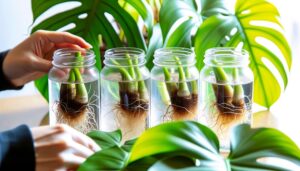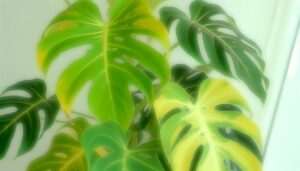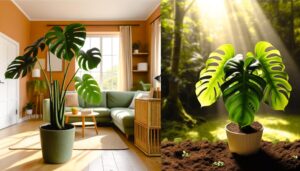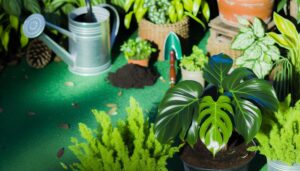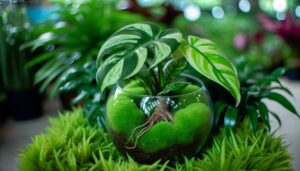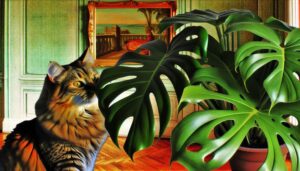Monstera Adansonii Archipelago Vs Albo
When comparing Monstera Adansonii Archipelago and Albo, you'll notice clear differences. The Archipelago boasts stable, marble-like variegation, while Albo displays unpredictable, striking white and green patches.
Archipelago's elongated, symmetrical leaves climb elegantly, showing geometric perforations. In contrast, Albo's broader, irregular foliage tends to trail and can have entire sections of white.
Archipelago prefers slightly drier conditions and high humidity, whereas Albo needs consistent moisture. Both thrive in bright, indirect light but too much direct sunlight can scorch them.
Soil should be well-draining with a mix of peat moss, perlite, and orchid bark. There's more to explore about these beauties.
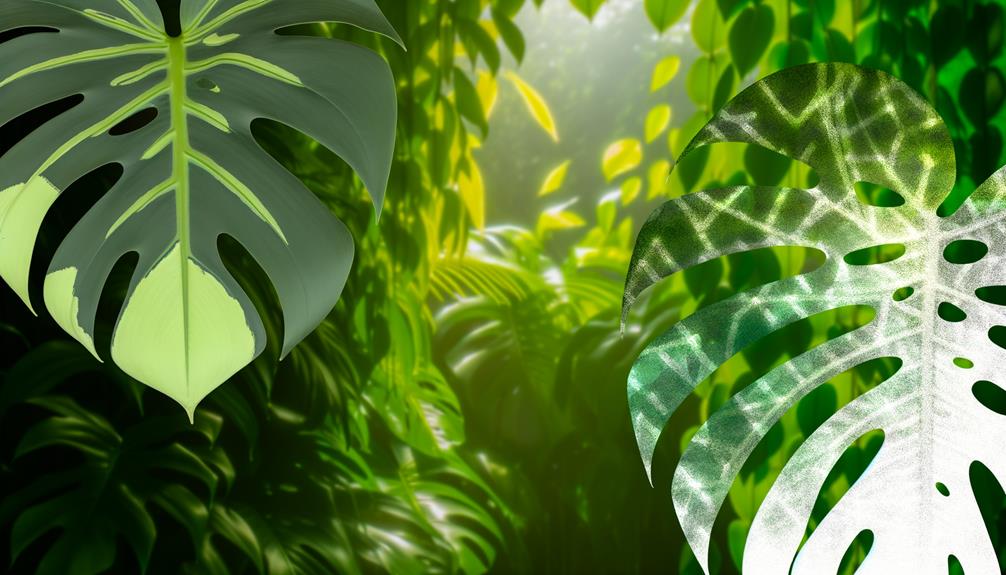
Key Takeaways
- Archipelago features stable, speckled variegation, while Albo has unpredictable white and green patches.
- Archipelago's leaves are elongated and symmetrical; Albo's are broader and irregular.
- Albo needs more frequent watering compared to Archipelago, which prefers slightly drier conditions.
- Both types thrive in bright, indirect light but Albo requires consistent brightness for optimal variegation.
- Archipelago is a climber with geometric leaf perforations, whereas Albo is a trailer with unique variegation patterns.
Appearance and Variegation
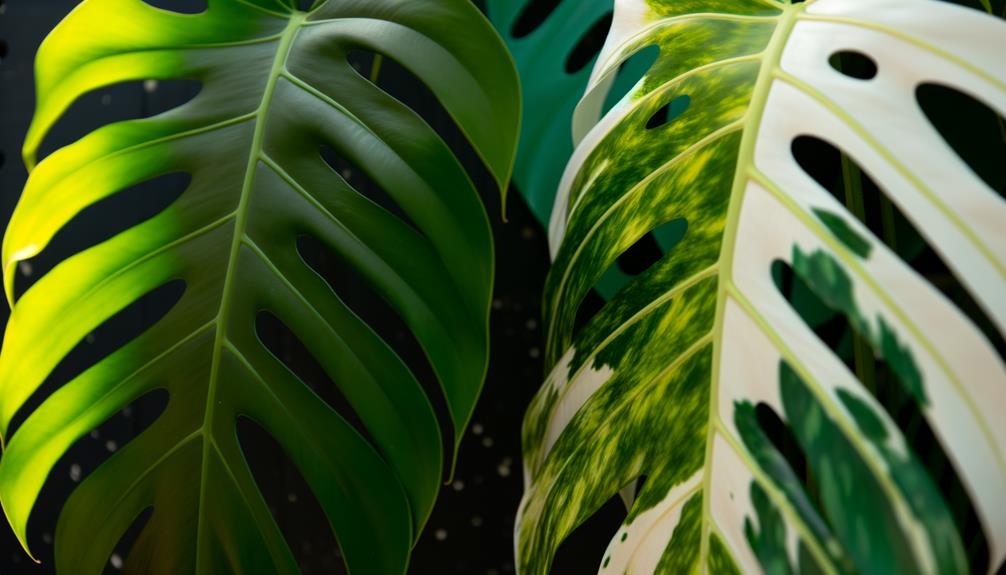
When comparing Monstera Adansonii Archipelago to Monstera Albo, you'll notice that the Archipelago typically exhibits a more stable and uniform variegation pattern, whereas the Albo features striking, unpredictable patches of white and green.
Archipelago's leaves often display a finer, speckled variegation, making it look almost marbled. This consistency is due to its genetic stability.
On the other hand, Albo's variegation can vary greatly from leaf to leaf, sometimes resulting in entirely white sections. This randomness makes Albo a visual spectacle but also renders it more susceptible to issues like reduced photosynthesis.
Growth Patterns
When examining the growth patterns of Monstera Adansonii Archipelago and Albo, you'll notice distinct leaf shape differences that affect their overall appearance.
Archipelago tends to have more elongated leaves, while Albo exhibits broader, more fenestrated foliage.
Additionally, Archipelago often prefers a climbing growth habit, whereas Albo is more inclined to trail, impacting how you might choose to display each plant.
Leaf Shape Differences
The Monstera Adansonii Archipelago exhibits elongated, narrow leaves with a distinct perforation pattern, contrasting sharply with the broader, more irregularly fenestrated leaves of the Monstera Adansonii Albo.
You'll notice that the Archipelago's leaves often have a symmetrical array of holes, creating a lace-like appearance. On the other hand, the Albo's leaves are more chaotic, with variegation adding to the irregularity.
These differences can affect how light penetrates through the foliage, impacting the plant's photosynthesis efficiency.
- Astonishing symmetry: Archipelago's leaves are a marvel of geometric precision.
- Unpredictable beauty: Albo's leaves surprise you with their uniqueness.
- Light play: The varying perforations create mesmerizing light patterns.
- Distinct identities: Each leaf tells a different story.
Understanding these differences can deepen your appreciation for both varieties.
Climbing Vs Trailing
Growth patterns in Monstera Adansonii Archipelago and Albo reveal distinct climbing and trailing tendencies that greatly influence their care requirements and aesthetic appeal.
Monstera Adansonii Archipelago exhibits a stronger inclination to climb, utilizing aerial roots to anchor itself to supports. You'll need to provide a moss pole or trellis to promote vertical growth.
In contrast, Monstera Albo often prefers to trail, cascading elegantly from hanging baskets. This trailing habit requires regular pruning to maintain shape and vigor.
Both species benefit from indirect light and well-draining soil, but these growth patterns dictate different structural supports and pruning techniques. Understanding these tendencies guarantees you can optimize their display and health, enhancing the visual impact in your space.
Light Requirements
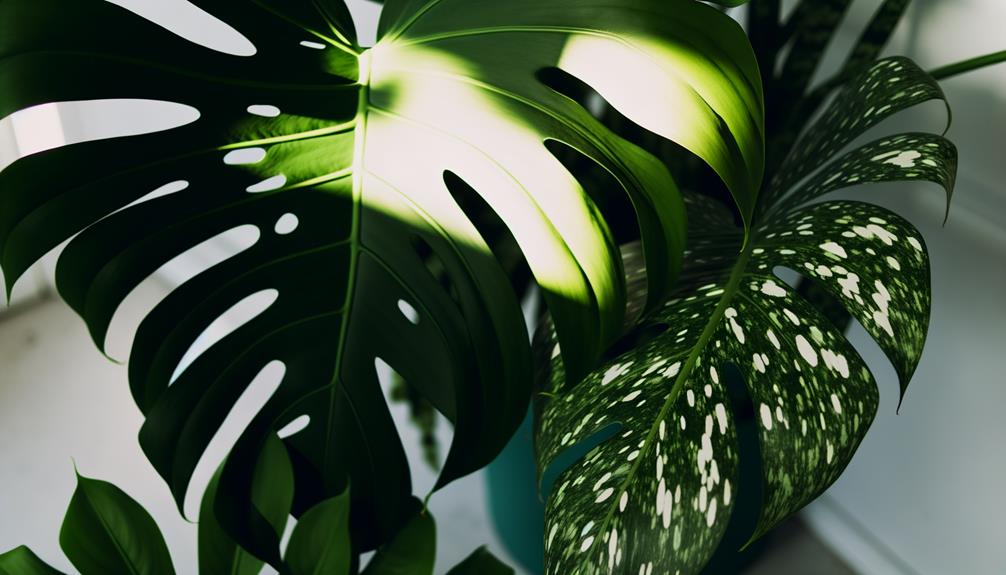
When considering the light requirements for Monstera Adansonii Archipelago and Albo, you'll need to focus on their ideal light conditions and their tolerance to varying light intensities.
Monstera Adansonii Archipelago thrives in bright, indirect light but can tolerate lower light levels, while Albo requires more consistent bright light to maintain its variegation.
You'll find that understanding these nuances is essential for optimizing their growth and health.
Ideal Light Conditions
Understanding the ideal light conditions for Monstera Adansonii Archipelago and Albo involves analyzing their natural habitats and specific light preferences to optimize growth and health. Both varieties thrive in conditions that mimic the dappled sunlight of their native tropical forests. You need to provide them with bright, indirect light to replicate this environment.
Direct sunlight can scorch their leaves, while too little light will stunt their growth and diminish their striking variegation.
- Bright, indirect light: Mimics their native habitat.
- Avoid direct sunlight: Prevents leaf burn.
- Consistent lighting: Promotes even growth.
- East-facing windows: Ideal for morning sun.
Light Intensity Tolerance
Monstera Adansonii Archipelago and Albo each display distinct light intensity tolerances that directly impact their photosynthetic efficiency and overall strength. You'll notice that the Archipelago thrives in medium light conditions, while the Albo prefers bright, indirect light. These preferences influence their growth patterns and foliage quality. For optimal health, avoid exposing them to direct sunlight, which can cause leaf burn.
| Monstera Type | Light Preference |
|---|---|
| Adansonii Archipelago | Medium, indirect light |
| Albo | Bright, indirect light |
Understanding these light requirements will help you provide the ideal environment for each plant. Monitor their leaf coloration and growth rate as indicators of light adequacy. Proper lighting guarantees robust photosynthesis, promoting lush, vibrant foliage and overall plant well-being.
Watering Needs
Both the Monstera Adansonii Archipelago and the Albo require consistent moisture levels, but their specific watering needs differ slightly due to their unique growth patterns and environmental preferences.
The Archipelago prefers to dry out slightly between waterings, thriving in environments with higher humidity.
On the other hand, the Albo needs a bit more frequent watering to maintain its vibrant variegation and overall health.
To evoke a deeper connection, consider these key points:
- �� Consistency: Both plants need regular, even moisture.
- �� Humidity: The Archipelago thrives in high humidity.
- �� Frequency: Albo needs slightly more frequent watering.
- �� Overwatering: Avoid waterlogging either plant to prevent root rot.
Soil Preferences
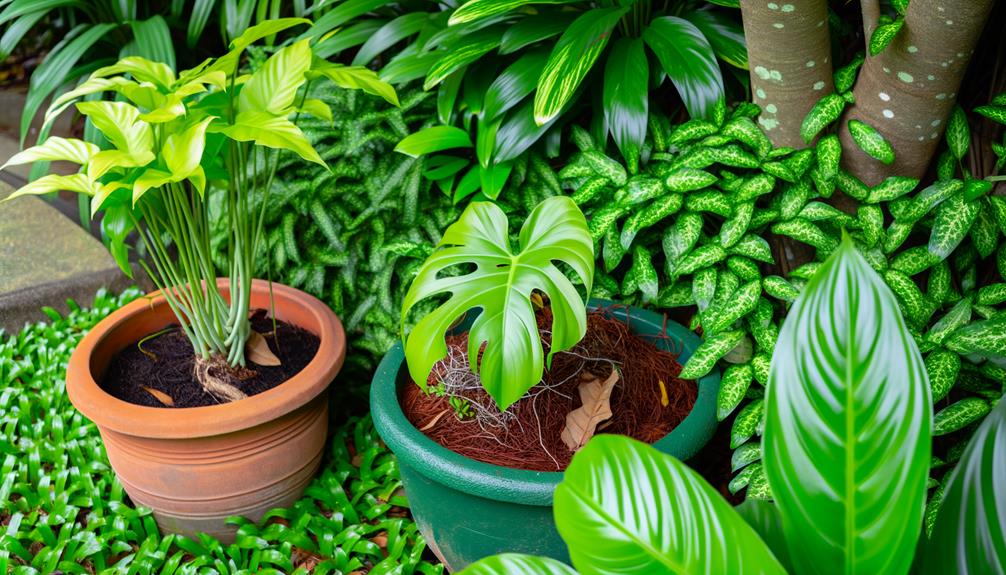
When selecting the right soil for your Monstera Adansonii Archipelago and Albo, aim for a well-draining mix that's rich in organic matter to support their robust root systems. Both varieties thrive in a blend of peat moss, perlite, and orchid bark. This combination provides aeration, moisture retention, and essential nutrients.
Guarantee the pH level remains slightly acidic to neutral, ideally between 5.5 and 7.0. The inclusion of perlite enhances drainage, preventing root rot—a common issue with overly moist soils. Adding orchid bark mimics their natural epiphytic environment, promoting root health.
Avoid dense, clay-heavy soils, as they can restrict oxygen flow and water movement. By optimizing these soil conditions, you'll foster healthy growth and vibrant foliage in your Monsteras.
Propagation Methods
With the best soil mix established, let's explore the most efficient propagation methods for Monstera Adansonii Archipelago and Albo.
Rooting cuttings in water is a popular choice due to its simplicity and success rate.
For a more controlled environment, you can use sphagnum moss, which retains moisture and provides aeration.
Soil propagation is another option, guaranteeing the cutting has consistent humidity and indirect light.
To conclude, air layering is a technique that encourages roots to form on the stem while still attached to the parent plant.
- Water Propagation: Easiest, visually engaging, high success rate.
- Sphagnum Moss: Retains moisture, promotes aeration.
- Soil Propagation: Consistent humidity, indirect light.
- Air Layering: Produces robust roots, keeps stem healthy.
These methods ensure robust and thriving new plants.
Conclusion
To sum up, the Monstera adansonii archipelago and albo each possess unique characteristics and requirements. Both provide exclusive variegation, however, the archipelago exhibits more robust growth patterns.
They've similar preferences for light and soil, although they vary slightly in watering requirements. When propagating, patience is crucial—good things come to those who wait.
Recognizing these distinctions will assist you in nurturing a flourishing plant, suited to your surroundings. Examining each aspect scientifically guarantees a healthy, stunning Monstera.

